As far back as the 1850s, slums existed in inner city Melbourne. Slum dwellers lived a squalid existence. Often, they had no bathrooms, or sewerage. They lived in ramshackle housing, with leaky roofs and holes in the walls.
[Collingwood]. Rear of No. 5 Hood Street; H2001.291/20
In 1923, active Methodist and social reformer F. Oswald Barnett visited an inner city slum. He was so shocked that he was moved to write the following lament:
WHAT CAN I DO?
Oh God.
What shall I do about these little ones,
These children of the slums,
These helpless, unwashed babies of the slums,
Who crawl along on bare and filthy floors,
Who feed with sticky flies,
Who play in evil-smelling lanes,
Whose mothers cannot keep them clean,
In body or in soul? [1]Carlton. Entrance to a slum pocket, c.a. 1930; H2001.291/12
Enlisting the help of other young Methodists, Barnett began a campaign for social change. Together, they successfully advocated for the establishment of the Methodist Babies’ House in South Yarra in 1929.
C’wood [i.e. Collingwood] open air wash-house; H2001.291/234
Barnett went further. Along with several other photographers, he began taking photos of the slums, using them as fuel in his push for social reform. The pictures, combined with emotive language, simultaneously shocked and captivated the public.
Carlton. Two mothers; H2001.291/9
Melbourne historian, Dr Andrew Brown-May, observes that from the 1850s onwards: ‘Slum depictions, fashioned in words and illustration, endured as a powerful genre in Melbourne’s cultural landscape.’ [2]
Slum portrayals were sensationalist and voyeuristic. Photos from the slums featured alcoholic mothers with loose moral standards, ‘vermin-infested kitchens’, and children riddled with fleas and head lice.
Fitzroy. The key of the front door of the apartment house; H2001.291/51
The campaign to rid Melbourne of its slums steadily gained momentum over the next century. In 1937 the Housing Investigation and Slum Abolition Board produced a damning report on the ‘slum menace’:
‘The Board records its horror and amazement at the deplorable conditions … Hidden behind wide, spacious streets there are slum pockets which are hotbeds of depravity and disease’. [3]
The Board recommended urgent measures to combat the problem, including the rehousing of slum dwellers and reclamation of slum areas. Its report led to the creation of the Housing Commission of Victoria.
Carlton [Kitchen interior with woman and three children], c.a. 1935; H2001.291/6
In 1938, the Victorian government passed legislation to facilitate a ‘war on slums.’ The Housing Commission was tasked with ‘excising’ slum pockets for the ‘common good’. [4] The Commission built flats to rehouse the slum dwellers. At the same time, it went about acquiring cheap land in suburbs such as Coburg, Brunswick, Northcote, Fitzroy and Richmond.
West Melbourne. The front view of a “Dudley Mansion; H2001.291/68
But abolishing the slums was proving to be difficult. The ‘demolitions program’ was beset with problems. By 1940, only 53 families had actually been moved into new houses. Synchronising demolition works with the building program was hard. The Commission did not have enough resources, and lacked the support of the labour movement. [5]
Behind the Scenes; H2001.291/267
The Housing Commission upped the ante. In the 1950s and 1960s, the Commission launched the most ambitious slum-clearance projects ever seen in Australia. Residents in Fitzroy, Collingwood and Richmond protested and refused to move. In 1969, the Carlton Association launched a PR campaign denouncing the schemes.
Finally, four years later, the Victorian government abandoned the slum clearance schemes, but by then, whole communities had been dismantled. The buildings that housed them had been demolished.
Society moved on to other concerns. But the slum stereotype lives on in our records. It is the only version of the truth that remains.
You can view the entire F. Oswald Barnett Collection online.
References
[1] Barnett, F.O. [1945?], I hear the tramp of millions, Rawson’s Book Shop, Melbourne
[2] ‘Slums’, Encyclopedia of Melbourne
[3] Housing Investigation and Slum Abolition Board, 1937, First (progress) report, with appendices and supplements [microform] : slum reclamation : housing for the lower-paid worker; short term programme, H.J. Green, Government Printer, Melbourne
[4] Freestone, R., 2010, Urban nation : Australia’s planning heritage, CSIRO Publishing in assoc. with the Dept. of Environment, Water, Heritage and Arts, & the Australian Heritage Council. p. 217
[5] Howe, R. (ed.), 1988, New houses for old : fifty years of public housing in Victoria 1938-1988, Ministry of Housing & Construction, Melbourne, p. 41

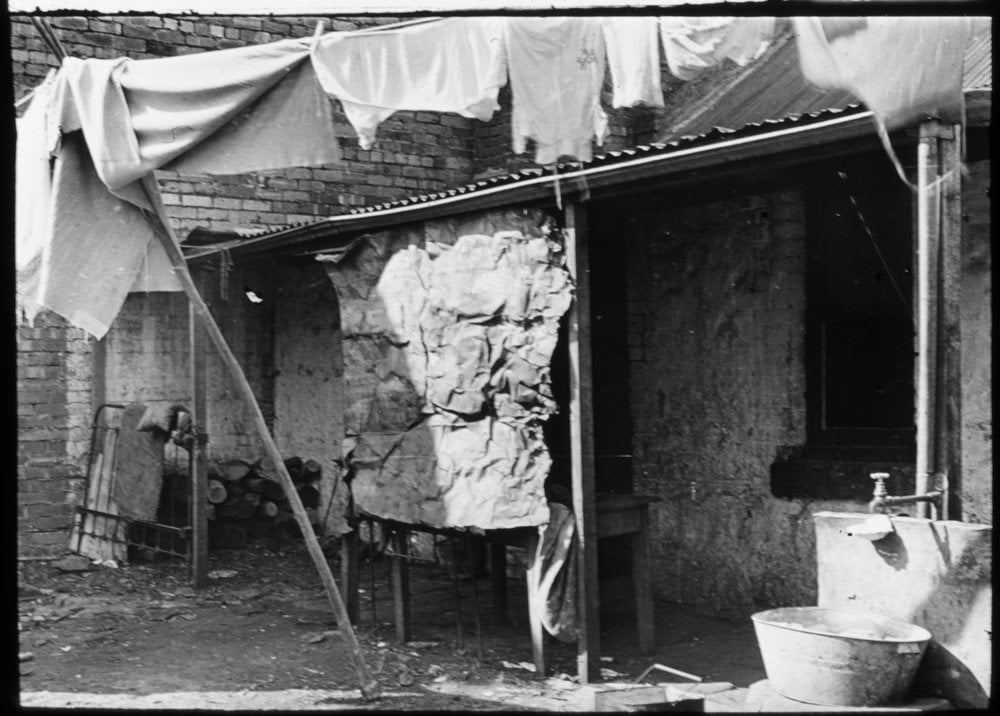
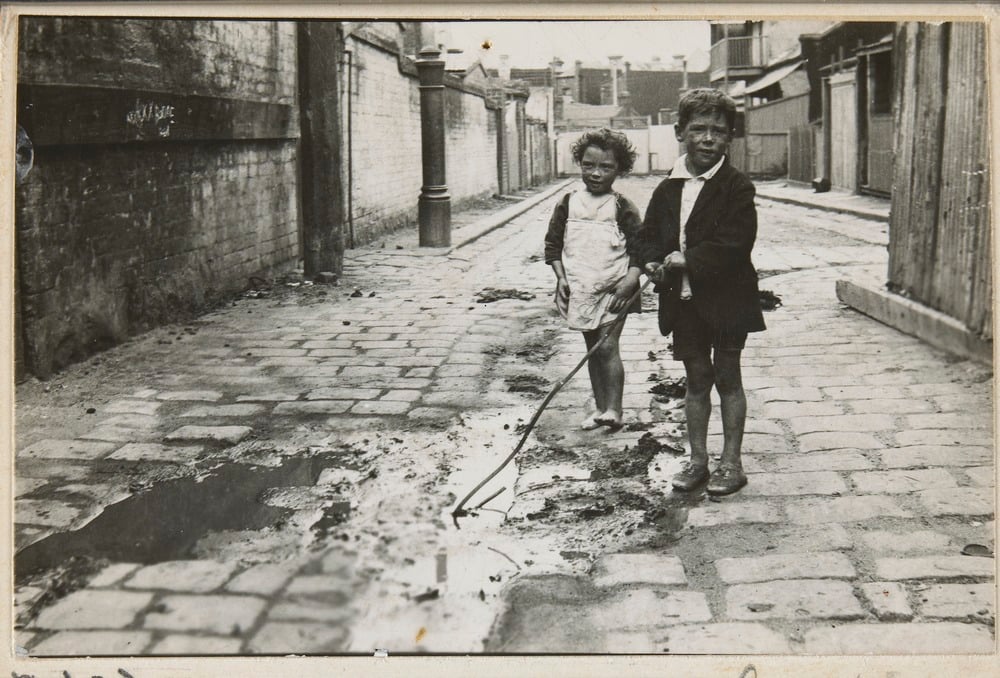
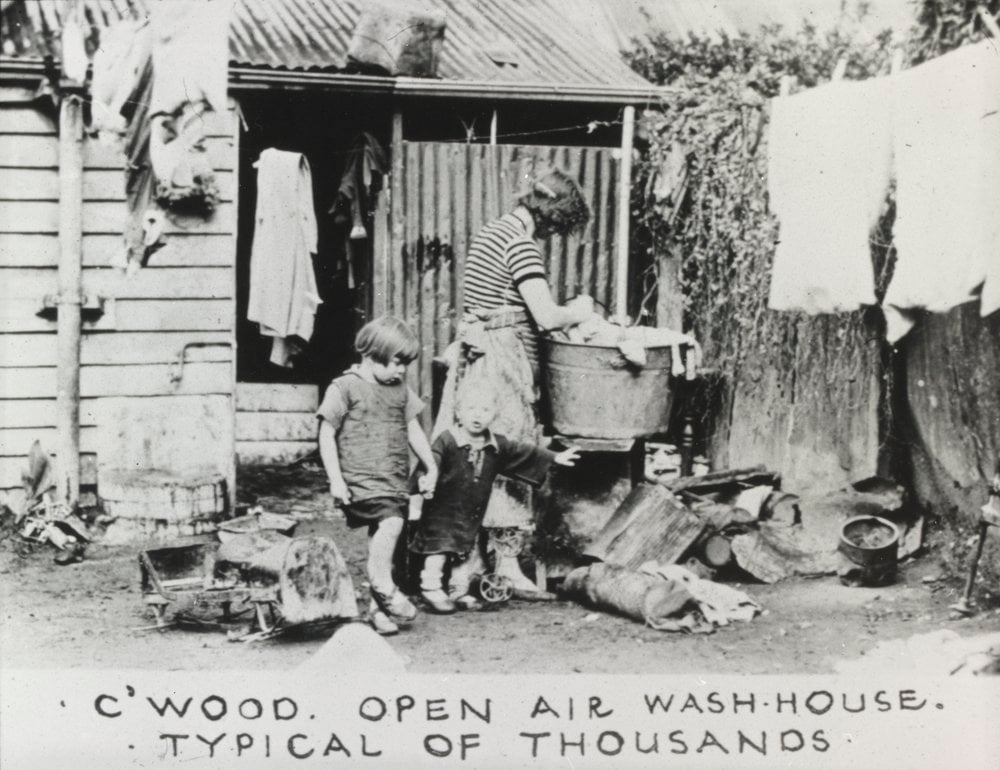

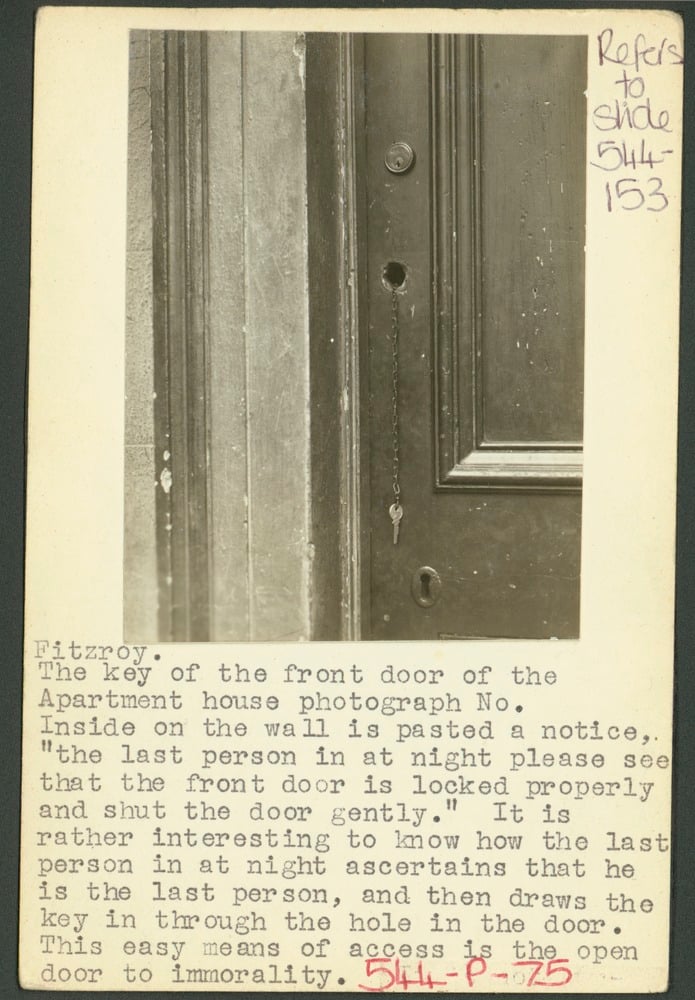
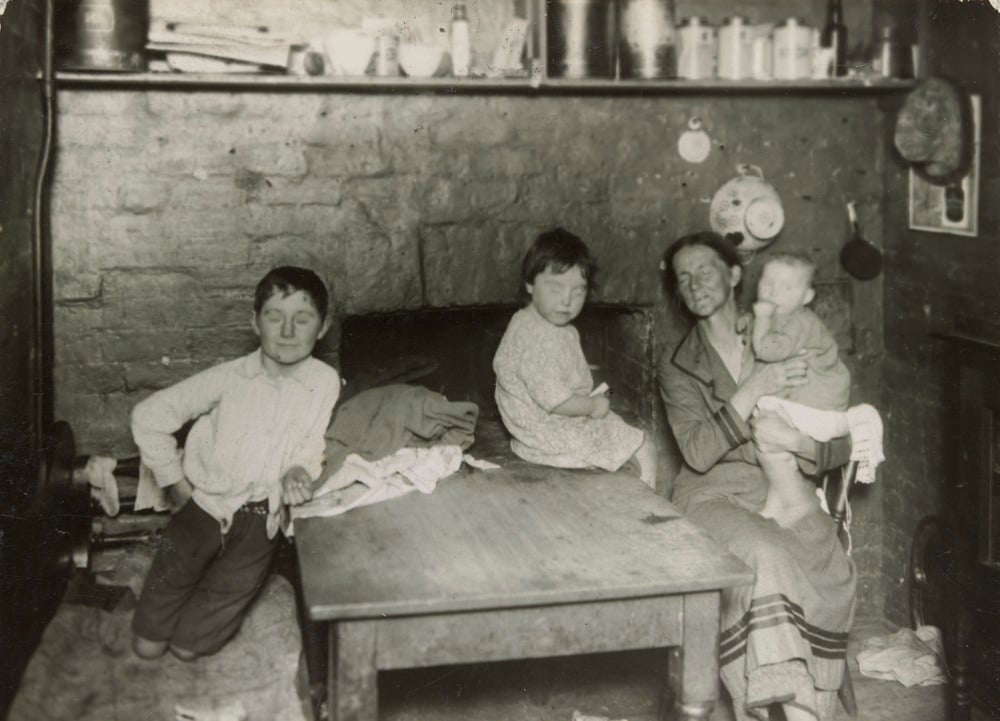
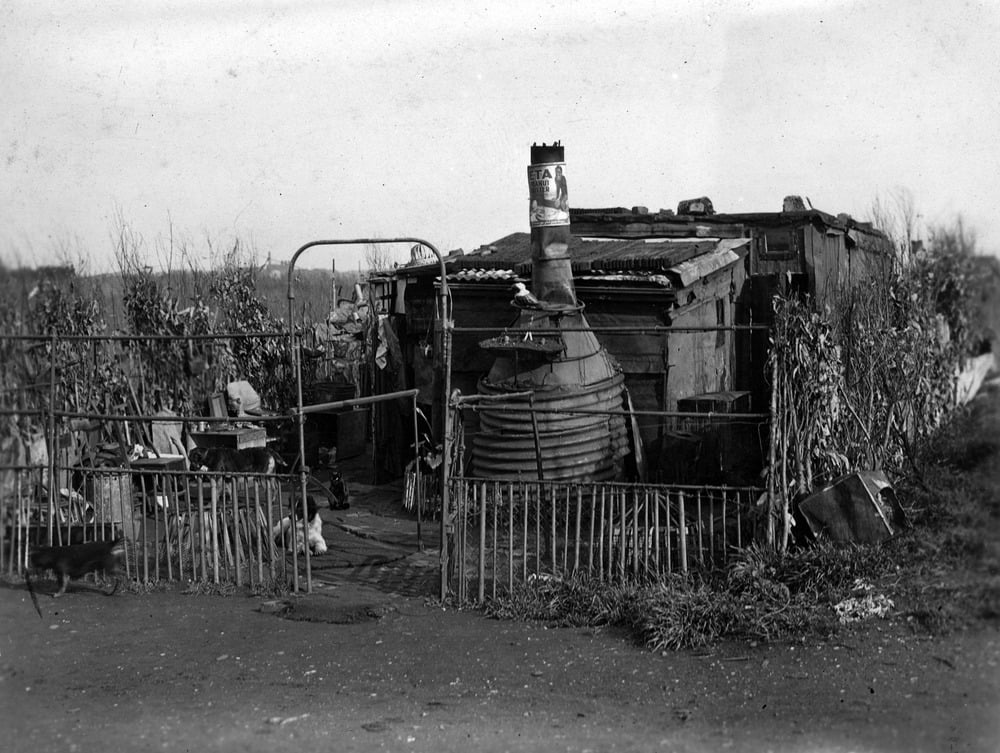
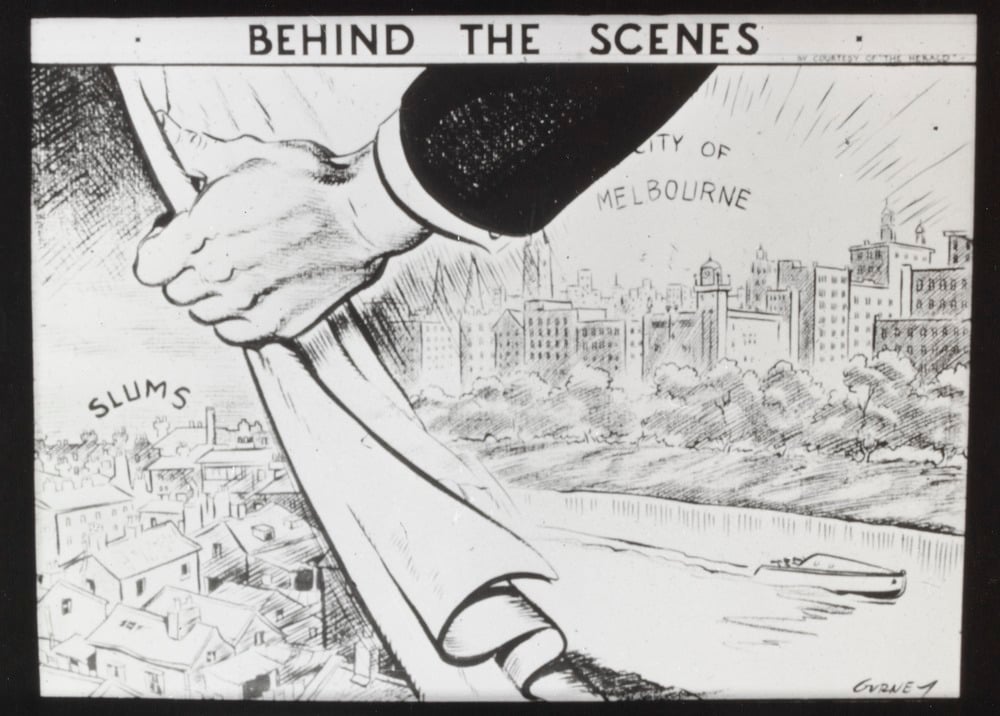

Can’t help thinking of my forebears. 5 children and her husband fell while painting the inside of the dome of the Royal Exhibition Building. Workers fund paid for funeral and then she was left to fend for herself. Took in sewing alterations and repairs to earn a measley sum. She was so busy and exhausted one of her babies ended up being accidentally scolded with boiling water and took days to die. She never got over it. Life was tough back then.
It sure was.
It was sad what families endured.proud that my family the Barnett’s could help maybe that is why myself and family won’t see people go with out.
Great work Sarah, Hard to believe the slum suburbs are now some of the most expensive and sough after areas for real estate.
John Charles
Thanks John. Glad you enjoyed it.
A really terrific blog Sarah. If you’re interested there’s some footage of Melbourne slums, from the 1940s, on the Australian Screen website – http://aso.gov.au/titles/sponsored-films/beautiful-melbourne
Thanks Ann. I will have a look.
Awesome! Thanks for sharing
A really great blog Sarah. Its heart breaking to read some of the facts regarding the poor of Melbourne. I never realised we even had slums of this magnitude!
Hi Sarah. I knew about the slum clearing of Fitzroy and Collingwood, but have always wanted to find out more about the Montague district in the South Melbourne area (side streets off Montague Street, the end of M Street past City Road intersection toward the West Gate Fwy). Apparently some little houses there were the first “bank houses” in Melbourne, built in the 3Os.The Montague District in it’s day had a bad reputation as an area housing undesirables, gangsters etc but apparently there is a whole other story to it having been a vibrant neighbourhood, which was again wiped out and sanitised by the city planners then. Would you know anything about this area’s history? I lived in one of the little bank houses a while back, and they were heritage listed because of their social history. Cheers Barb
Hi Barb, Susan Priestley’s book: ‘South Melbourne. A history’ contains some fantastic information about Montague. The book is on our open access shelves in the library. Apparently Montague was a close knit community, with a ‘love of a stoush’. Communist Party organiser Tom Hills described Montague as: ‘really poor… much poorer than Port. Damp and decaying little houses always being flooded… The Montague crowd were a group within themselves… Nobody used to go in there with the Party press bar me, because they weren’t game to. They’d have a go at them’. (pp 295-297)
The City of Port Phillip prepared this background paper on Montague in 2011: http://www.portphillip.vic.gov.au/Montague_Background_Paper.pdf
The National Library of Australia’s web search engine Trove is also an excellent source of information:http://trove.nla.gov.au/
Glad you enjoyed the blog. Sarah.
Barb, not exactly sure about the Montague section you mention, but the State Savings Bank of Vic (as it was at the time) built Garden City as semi social housing in the late 1920s and early 1930s. The bank made it easy for people to get finance to buy the Bank Houses, and while strictly speaking they were never social housing, in the sense that Housing Commission accommodation was later, these houses did make it possible for many people to buy houses that they would have otherwise been unable to afford. The area/streets was laid out on British “Garden City” principles, the theory being, briefly, that pleasant surroundings and decent houses were more likely to have occupants take care of their houses and pride in their surroundings. If you can get hold of Renate Howe’s book, New Houses for Old, mentioned in the references to the original blog article, there will probably be mentions in that too. Her husband, Brian, former State Govt Minister, was lecturing at Swinburne at the time, and his class in Urban Sociology did alot of work in that area. Somewhere I have my 5000 word research paper on social housing from this period produced for the course! Recently one of the Garden City houses was sold, and the idiot estate agent had stuff in the advert like “Where else would you find a house so close to the city with 2 staircases, one for the staff”. I nearly fell off my chair – the houses were built as 2-up 2-down duplexes, and a few have been bought as pairs and knocked together to form one larger house! There’s more on Garden City at:
https://en.wikipedia.org/wiki/Garden_City,_Victoria
The Montague houses are in Gladstone St. built under the auspices of the council. Janet Bolitho has written concisely on these here http://www.portplaces.com/bank-houses-in-montague/
Also note, that the slum clearances were championed in the Housing Commission by Os Barnett’s son-in-law Raymond Burkitt. They were both driven by a philosophy of essentially a “clean environment” meant “good morals” – so the rationale for slum clearance had a religious undertone as well as a social engineering one. Os Barnett was also a advocate of adoption and established the Methodists’ Babies Home to allow slum babies to find “better” homes.
Fascinating! Those images are amazing too. Its inspiring to see that a difference can be made from 1 person being moved. Thanks for this post!
thanks for the blog sarah, they are a great set of photos. Your outline illustrates well how loaded the term ‘slum’ was, and why historians need to be careful of uncritically accepting Barnett’s judgement – as Lyn says, his agenda was essentially religious, and one person’s slum is another person’s home. Making the collection available gives us a wonderful opportunity to think beyond his revulsion and interpret the images in less moralizing ways.
Pingback: Squizzy Taylor in Richmond | Melbourne Circle: stories from the suburbs
i remember many years ago when working as a nurse in conversation to a group of patients talking about “the good old days”…one elderly man quickly turned to me and said…there was no such thing as the good old days girlie…ive never forgotten his words and looking at these photos how true for so many, thanks for this amazing look into the past
Yes indeed, there’s a lot of mythologising about how great those old slum communities were, fed in part by Ruth Park’s Harp in the South and the TV series made of it in the 1970s.
In the 1970s, I had friends and relations who had moved out of the slums and had not a good word to say for them. Stella, an old lady who’d been single all her life, had been ecstatic to be moved into a new Housing Commission flat. It was the first time in her life she’d had running water and a proper toilet. She liked being able to keep herself clean and to have clean clothes too. They did not miss the rats and the lice either.
None of them missed the violence and assaults and the thefts of the pitiful possessions that they had. And their health improved because they were not living cheek-by-jowl with people who had TB and other communicable diseases.
There are always people who like to romanticise the past and they have certainly had the ascendancy when it comes to slum clearance in Melbourne. The voices of people who were pleased to escape the slums have been dismissed as irrelevant by people who have no idea what it was really like.
When I played with the kids outside in Bentleigh 1950s my mum would come outside and bring me in saying to me”Come inside ! You sound like you were born in Richmond!” Had I been born in Richmond I’d be a millionaire now! I love Richmond
My family lived in Abbotsford, and we thought it was a bit better than Collingwood. Ha Ha
But it really wasn’t.
I remember lots of places you had to be careful where you walked.
I also remember that having a buttered biscuit was a delight.
Our place was clean and Mother kept it shining but I know of others that were smelling of beer and never saw a broom or a mop.
Thanks for sharing it came out well, Slums are a result of poor planning or the lack thereof. Everyone deserves clean water and enough food every other day. Capitalists looking for a quick buck are propagating this acceptability of slums. I say no to slums and poverty. This world has enough for everyone to live a happy and productive life.
Glad Australia took steps to rectify the slum problem in Melbourne. It was tried in a slum in the city of Nairobi in Kenya but the slum dwellers were the greatest hurdle as they refused to move. it has never been completed to date.
Pingback: Why 100 years without slum housing in Australia is coming to an end | Em News
Pingback: Why 100 years without slum housing in Australia is coming to an end – Digital Finance Analytics (DFA) Blog
Pingback: Why 100 years without slum housing in Australia is coming to an end | Theresa Worrell Blog
My birth mother lived in Kensington in a boarding house , she had many babies maybe due to the terrible times and she adopted them out, all six of us , so many stories of alcohol and very poor living conditions ,she did keep one child who had no shoes ,and very little food and had strange men hanging round our birth mother and having to wait in dark alleys for her mum to return and spent many hours as a little child waiting in the cold with a hungry tummy . I’m glad I was adopted out of the area and into to the arms of a loving family .
I lived in North Melbourne until I was 16. Our house was OK only because my father painted and improved the house. Some of my happiest times were spent in North Melbourne. I have friends from that time, unfortunately from 7 of us there is only 3 left. We had wonderful neighbours who would always help each other. I was educated in North Melbourne, both primary and secondary.
Carlton bred and born and brought up in West Melbourne, this 65 year old remembers being able to roam the streets til sunset (about 9pm in our now summertime); a block with three english speaking families and massive friends among the Maltese neighbours who shared their table, (and first tv), rosary at night, toast from the gas grill of their ‘kooka’ etc … all accessed via a front door or tree between our backyards …. Re baths – remember father building bathroom in the mid fifties, before then we had a tin bath for kids and washing (together with a big copper) and victorian one in the same outside washhouse. I remember teh ‘iceman cometh’, as did the baker and the milkman – pretty good that as it also brought horse manure for the back garden in our 16′ by 116′ block (2 bedrooms housed a mother, father, grandmother grandfather and three children)… Crowded perhaps even when the verandah was enclosed for a third bedroom (mine) that accessed the main part of the house by exiting the narrow sleep-out and then entering the front door. The school (King Street, West Melbourne) likewise had an incredibly mixed population that was typical of inner city areas in the post-war years …. and walking to and from school one heard music from around teh world, smelt cooking from far-away places and LOVED EVERY STEP. In this environment one grew to love the sound of foreign languages (later studied two) and history, language etc… The Vic markets a walk away and a tram fare home – the sights of the city able to e window-shopped (no spending here); the Loco (Cinema) Theatre (Victoria street) (thanks to the union) brought delights and horrors (the Three Stooges I counted among the latter); and dad could walk to work at the now notorious Power Station near Spencer Street … You could hear the crowd from Festival Hall from your bed – and swim in the City Baths or North Melbourne Baths (thanks respective councils for delighting the children from generally poorer families). Friends spoke of moving to the new towers built to replace their ‘slum’ homes – I took one trip up and thought here were the windy slums of tomorrow if not today …. Still find the area wonderful though too expensive now for the likes of me … esp intesting is the three dates for the area of West-North Melb … thanks to the former Aslyum/Poor house etc thatr once crossed Victoria Street. There are stone homes from teh 1840s, Victorian terraces and then later after the demolition of the institution came post Federation … it is still a most interesting walk. Thanks for the memories, Sarah.
I too grew up in Nth Melb. Had a wonderful childhood.
Hello Sarah,
Your blog is very interesting and although I’ve done a fair bit of research in this area (the slums of early Melbourne) I still found some helpful facts for my writing.
I am writing a novel, a large part of which is set in 1930’s Melbourne in the poorer inner-city areas. I require some information about how poor people were treated when they died; did a worker’s fund pay for a funeral, did a charity pay? What would a small child’s funeral be like? I have searched the internet but no luck yet. I’m sure the State Library would have some good information on this subject. I’d be grateful if you could point me in the right direction.
Hi Camille, Thank you for your interest in our blog. I’m glad you enjoyed it. I will send some further references to your email address. Sarah
Hello Sarah
I was also was born in West Brunswick 1940`s All of my family had a comfortable home, with good food and clothing .The reason I am replying to you I am doing family research writing a book for my grandchildren, What I am looking for is some information about the men playing Two up in the back lanes of Carlton area where my grandmother lived. The men would play the game in the back lanes and us kids would have to run a stick along a tin fence if we saw the police coming , do you have any information about the game Regards Patricia Witt( Middleton)
Hi Patricia, thanks for your comment. I will log your enquiry with our Ask a librarian service and one of our librarians will get back to you. Sarah
Images are Great Thanks for sharing…
Tough times in the inner city. Incredible to see these homes. My descendants lived in this area from the last quarter of the 1800s through to the 1930’s and beyond. Gatehouse Lane Collingwood where they first settled has been cleared. The median price of residences in Collingwood now is up around $1 million.
Correction:Glasshouse Lane not Gatehouse
My mum, then aged seven, moved with her parents from South Melbourne to Oakleigh in 1934.
Mum described her mum, talking with a neighbour over the fence about whether they had food for their kids… my nan said she still had a crust of bread saved for mum, but would just drink tea again herself.
Everyone was struggling: it was during the Depression and there was no work for so many. At South Melbourne my grandmother had family and friends nearby though… company, and people to help or be helped by.
The move to Oakleigh that should have been wonderful was a misery for Nan. She knew she was lucky to have a nice house in a new estate (ex market garden), but was lonely, hated the quiet, and felt inadequate.
I wonder how many others felt like that. Awful as living conditions were in some urban neighbourhoods, shared hardships made for an interconnectedness the new suburbs couldn’t provide.
There are no simple solutions to complex social problems… not then, not now, not ever.
I remember my mum telling me that when they first moved down from Albury,they lived in Brunswick – running a milk bar. It wasn’t slums but the laneways ran directly beside their house. They had to have bars on the windows because men played two up in the alley. Squizzy Taylor was renowned for playing there.
I grew up in a beautiful home and magnificent garden in Cherry Road Balwyn originally built by F Oswald Barnett in 1908. That house and its sadly neglected garden is currently awaiting the developer’s sledge hammer to knock it down and build 16 apartments.
Great article thanks for sharin:)
You could add this beauty.
https://www.facebook.com/photo.php?fbid=2479083348814165&set=gm.781754585587797&type=3&theater&ifg=1
I was born at the Royal Women’s Hospital in 1941. Went from there to Belair Street Kensington until I was about 6 months and then mum, dad and I moved to 302 Dryburgh street in North Melbourne. 302 was at the bottom of Dryburgh street near Haines street.
We rented a three room house on a block about 4+ metres wide (about 15 feet). We were just across from the North Melbourne baths and the North Melbourne football ground. We lived there until I was 6.
When I turned 3 I went to the Lady Huntingfield kindergarten and then to St Michael’s Catholic school in Brougham street just near the top of Abbotsford street and Flemington road. We moved to the corner of Canning and Kipling streets in about 1947, this time into a 7 room house with my father’s mother. We stayed here until 1959 or 1960. Then we moved to West Footscray…saddest day of my life: Had to leave all my mates.
Frankie, Eric, Barry, Chooka, Duffy, Crackers, Slug, Joey, Mick, John, Freddie, Arab, Max, Nicky, another Freddie and another Max, Ernie, another Frankie, Ronnie, Mickey, Ralph, Burkey, Johnny, about 7 young females and a few more of both sexes that I cannot remember.
Mostly we hung around a milk bar at the top of Abbotsford street.
Some of those named above lived in homes that were acquired by the Housing Commission. The Housing Commission went through North Melbourne like petrol ants. Canning street from below Melrose street to Boundary road: From Boundary road to Alfred street and from Alfred street to Melrose and back to Canning street.
Not only long standing friendships were broken, but the hearts of kids who played together with ball bearing trucks…with penny bungers and sky rockets on cracker nights, loved the fish and chips from Phils…went to Saturday matinees together and screamed their lungs out at the Arden street oval when North were the easy beats….their young hearts were broken too!
Eric, Frankie and I are in our late 70s now. We meet about every month at Barkers Café (the Footscray football ground). We have children, grandchildren and great grand children. Mainly we reminisce about our lives in North Melbourne: How we loved it then and how we feel the same now.
It was a Tom Sawyer, Huckleberry Finn type of life for us kids. We were all poor together but we never knew it.
How I loved North Melbourne
Thanks for posting this, beautifully written.
Larissa
Absolute fascinating article and blog. I used to work in and around South Melbourne, Port Melbourne and Garden City for the MOH. Supervised so many upgrades on these properties and learned so much about heritage buildings and their history. I really didn’t know too much about the slums, thanks for sharing.
A fabulous blog
The comments should be required reading for elected officials in all levels of government.
They show how opinions formed about a life – seen from the outside – can be quite different to those of the person living that life.
Above all these comments show how important social connections are.
I recommend reading the comments of Leo, 3 Nov 2019. What a memory. Friendships still celebrated 70 years on.
Melbourne councillors and state politicians who owned big shops in the city concerned with opening up of outer shopping centres eg chadstone northland etc we’re behind destroying communities in inner suburbs They needed the population high around the city to keep up their profits our house was pulled down in Webb st Fitzroy they also attempted to takeover councils such as Fitzroy but lost in court thanks to our young town clerk John james
It is easy for better off members of society to harshly judge those who are struggling in a world that gives the disadvantaged very few opportunities to improve their circumstances. Welfare workers have blinkers and predjudices even today.
Thank you Sarah. My forebears lived in the poorer (slum) areas of Collingwood, Fitzroy, and South Melbourne areas, so this was very interesting to me.
Anybody out there know of 19th Century photographs of Glasshouse Lane? My Irish ancestors lived there.
Hi John, thanks for your question. I will log it with our reference service, and one of our librarians will get back to you. Sarah
Hi, I lived at 125A Chetwynd Street North Melbourne from 1950 to 1965. I was wanting to find out more about the history of the house etc. I remember my mother washing clothes in the outside “Copper”. Cutting up newspapers into squares to use in the toilet, the bath was in the kitchen. A small shed attached to the house had a double concrete washing trough. Attached to the trough was a “ringer” which mum used to push the washed clothes through to squeeze out the water before hanging the clothes on the line. I attended King Street State School in North Melbourne, which I believe is now owned/run by the Salvation Army. I attended Flemington Girls Secondary School in Flemington. I attended the Methodist Mission in Errol Street North Melbourne and was a member of “Ray of Sunshine” girls club. We went on camps to Dromana. When my dad died in 1956, my mum was 39 years old. The government said she was young enough to go out to work. But because she had four children and the youngest two being twins at 6 years old, they decided to give her the widows pension. Which enabled mum to keep us all together. Regards Cheryl
Hi Cheryl, Thanks for your interest. I will log your question with our Ask a Librarian service and one of our Librarians will get back to you. Sarah
My childhood home was Curzon Street North Melbourne and i attended Errol Street Primary, all wonderful memories. My Grandparents lived at 103 Green Street Richmond.
So sad that no photos are available of the homes back then.
Is there a source that I can get to that discusses/describes pensions and support that unemployed slum residents might have had access to in 1935? For instance, how much of the overall income did 5 shillings a week represent?
Hi Frank, thanks for your interest. I will log your enquiry with our Ask a librarian service and one of our librarians will get back to you. Sarah
I would have thought the Sutherland Homes for Neglected Children would have addressed part of the problem associated with the plight of numerous “street kids” inhabiting these dreadful slums.
Hi Sarah!
this is an awesome blog! It is truly helpful and one of the only things i could find on this topic, keep up the good work!